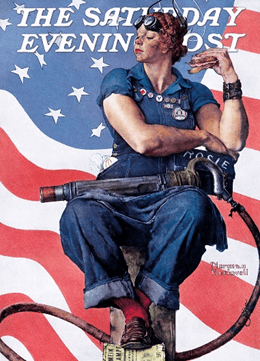“WE CAN DO IT” CAMPAIGN

Rosie the Riveter is an iconic propaganda image utilized during World War II at recruiting female workers to support the war effort, but it is thought that she inspired much more. She ultimately became the iconic image of the American working woman. Prior to World War II, there was less than 1 percent of women in the workforce. With American men answering the call to arms, American women were needed in the workforce to help America win the war. Rosie the Riveter was the image that motivated that call. Rosie the Riveter was actually a media campaign targeted at changing mainstream America’s idea of a women’s role in society. The media campaign consisted of movies, posters, photos, newspaper articles, etc., which stressed the patriotic need for women to enter the workforce.
One example of such propaganda is The Saturday Evening Post cover published by Norman Rockwell, portraying Rosie with a flag in the background and a copy of Adolf Hitler’s racist tract “Mein Kampf” under her feet (May 29, 1943 issue).
While Rockwell’s image is a commonly known version of Rosie the Riveter, the most famous image of Rosie was created in 1942 by an artist named J. Howard Miller, and was featured on a poster for Westinghouse Electric Corporation headlined “We Can Do It!”
The Rosie Campaign had a significant effect on American society. Not only was there artwork such as Mr. Rockwell’s, but:
- In 1942, Redd Evans and John Jacob Loeb composed a song called “Rosie the Riveter.”
- Women who worked in the war effort began to call themselves “Rosies.”
- The U.S. Postal Service issued a stamp in the 1990s featuring the image of Rosie the Riveter.
As a result of the campaign, women in the workforce increased to nearly 37 percent during the war, and by 1945 nearly one out of every four married women worked outside the home.

During World War II, the aviation industry saw the greatest increase in female workers. More than 310,000 women worked in the U.S. aircraft industry in 1943, making up 65 percent of the aircraft industry’s total workforce.
The idea of women in the workforce during World War II was meant to be temporary and women were expected to leave their jobs after the war and return to their domestic duties. And, although women who entered the workforce during World War II were crucial to the war effort, their pay continued to lag far behind their male counterparts: Female workers generally earned less than 50 percent of their male counterparts and were usually demoted once men began to return to their previous professions. The impact of World War II on women and the role that Rose the Riveter played in that change, altered the workplace forever.
Become a supporter today of the U.S. Army Museum of Hawaii, by purchasing a souvenir Ha-Go Shirt. All donations support the maintenance and upkeep of the our artifacts and exhibits.
We look forward to seeing you soon!
